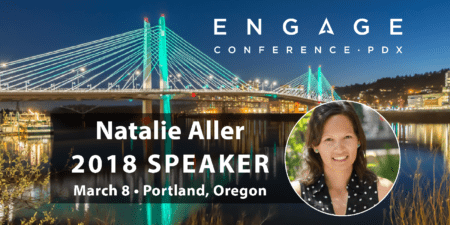Natalie Aller will be speaking on Mobile Apps at Engage 2018, which will take place March 8th, 2018 in Portland, Oregon. For more information or to purchase tickets, please click here.

1) Please give us your background and let us know what you do for a living.
I have worked in digital marketing for the past 10 years and specifically in mobile app user acquisition for the past 8 years. I started my app career running the marketing department for a mobile app start-up as their 5th employee. When I left, the company had over 300 apps on the App Store & Google Play. I also worked on the apps marketing team at Disney for two years where I was in charge of user acquisition for their portfolio of over 100 children’s and family apps. I joined 3Q Digital in 2016 and currently lead the mobile team where our job is to help our clients run successful mobile app user acquisition and re-engagement programs across many channels including Google, Facebook, Apple Search and mobile ad networks.
My favorite thing about working in the mobile app space is how quickly the industry changes. The top players are innovating daily and that affects the whole market. Always testing new tactics and strategies is crucial. My favorite thing about working at 3Q is the great clients and apps we get to work with from small start-ups to global powerhouse brands and getting to apply different approaches to solve each business’ unique challenges.
2. What should be included in the conversion funnel for an app?
App install
App sessions
Sign-up/registration
First purchase event + amount spent
Subsequent purchase events + amount spent (each subsequent event should be broken out separately, at least the 3-5)
That’s the basic conversion funnel for an e-commerce-type app. You need the install > registration > first purchase funnel in order to run a simple user acquisition campaign with a CAC goal. And just like desktop campaigns, depending on how long the buying and decision process is and how difficult it is to convert someone into a paid customer, you may add more upper funnel events as needed.
For re-engagement campaigns, you’ll use these events to look at your users through the lens of retention (app sessions) and then be moving them through the funnel all the way to first purchase and subsequent purchases.
There are many other app business models which will have a different conversion version of this conversion funnel. For example, apps that are subscription-based will focus on a free trial and eventual subscription, then monitor subscription retention and churn rate. Other apps make money purely on ad-revenue and they typically optimize towards an LTV metric wherein you’ll need to track different proxy events that lead to a high LTV (usually number of app sessions and length of app sessions), and there are other apps such as games which also have an LTV calculation but it is derived through endless combinations of in-app purchases, all of which would need to be tracked.
3. Pros and cons of Facebook, Google, Apple Search
Facebook:
Pros:
Huge reach
Very effective LAL audience capabilities
Great mix of passive & engaged usage behavior leads to high conversion rates
Flexibility and variety of ad units
Cons:
The platform is becoming saturated and expensive
Google Universal App Campaigns:
Pros:
This is the only place where you can access high intent search inventory on Google Search and on the Google Play store
Given that Universal App Campaigns are still in their early days there is significant product innovation occurring regularly such as: new inventory, new campaign types, new ad units, and improved audience targeting.
UAC optimizations are powered by Google’s machine learning that utilizes a growing pool of data points that Google has on the devices it reaches. As UAC matures, this optimization is getting stronger.
Automatic creative optimization
Codeless install attribution and dynamically-created ad units makes UAC very simple to set up.
Cons:
All app install campaigns must be purchased via a UAC campaign. You cannot buy only search or only display traffic.
Visibility and control into granular targeting, bidding, optimizations, and performance is limited.
Limited scale on iOS
Apple Search:
Pros
Very high intent channel
The majority of consumers still find apps by searching directly in the App Store
Relatively cheap installs for now, except in very competitive categories
Codeless install attribution and dynamically created ad units makes campaigns easy to set-up
Cons
Optimization algorithm can only go as far as CPI (no optimization towards a post-install event)
Apple will not allow postbacks from a mobile attribution vendor in order to optimize towards a post-install event
Scale can be relatively low for non-brand terms in certain categories
Todd Mintz knows PPC…knows Social Media…knows SEO…knows Blogging…knows Domaining…and knows them all real well. He runs growth marketing for )and is also a Director & Founding Member of SEMpdx: Portland, Oregon’s Search Engine Marketing Association, and he can be found here on Twitter and Facebook.
